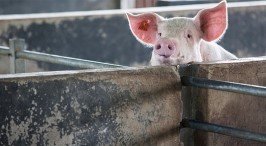Most likely ASF transmission route may be through processed or raw pork products, not live animal transport. Japan reported unrelated outbreak of classical swine fever.
September 10, 2018

The outbreak of African swine fever (ASF) in China, which authorities there first detected last month, is accelerating and will almost certainly emerge in other countries in Asia, a regional emergency meeting convened by the U.N. Food & Agriculture Organization (FAO) discussed Sept. 7.
ASF was first detected in Asia last year in an area of Siberia in the Russian Federation, FAO said, but its arrival in China is a major threat to the swine industry and to the livelihoods of small-scale farmers and others along the value chain. China produces half of the world’s pigs, with a current population of some 500 million swine. In just over a month, the virus has been detected in 18 farms or abattoirs in six provinces — in some cases more than 1,000 km apart — as of Sept. 7, FAO said.
There is no vaccine and no cure for the disease. In its most virulent strain, it is 100% fatal to infected pigs. However, unlike swine influenza virus, ASF poses no direct health threat to humans.
Responding to outbreaks of ASF is extremely challenging, experts at the emergency meeting have explained.
“The most likely explanation, and the reason for the vast distances the virus has traveled, is through processed or raw pork products and less likely through the movement of live animals,” FAO chief veterinary officer Juan Lubroth said at the emergency meeting. “The virus is very robust and can survive for weeks or months when it is used in cured or salted pork or when it is used in animal feed or swill.”
Because pork is produced and consumed in so many Asian countries, particularly in East and Southeast Asia, the introduction of the virus to other countries in the region is a near certainty, experts said on the final day of the FAO emergency meeting.
“Unfortunately, what we’re seeing so far is just the tip of the iceberg,” Lubroth said. “The geographical spread, of which ASF has been repeated in such a short period of time, means that transboundary emergence of the virus, likely through movements of products containing infected pork, will almost certainly occur. So, it’s no longer ‘if’ that will happen but when and what we can do collaboratively to prevent and minimize the damage.”
China and FAO have been working together over a period of several years in anticipation that ASF would one day arrive in the country and have developed protocols and detection plans, the international agency said. These protocols have helped veterinary authorities and others respond quickly and isolate areas where ASF detections have occurred. As of Sept. 7, nearly 40,000 infected animals have been culled in efforts to limit the spread.
“The Chinese authorities have taken this outbreak very seriously and have been very proactive in sharing information and their lessons learned with FAO and neighboring countries about the spread of the virus and their actions so far,” said Wantanee Kalpravidh, FAO Asia regional manager of the Emergency Centre for Transboundary Animal Diseases.
The emergency meeting, convened in Bangkok, Thailand, drew veterinary authorities and many other stakeholders from 12 countries, including the private sector, ASF experts and representatives of the World Organization for Animal Health (OIE). The meeting concluded with the formation of a specialized regional network that has pledged to work together and respond aggressively and collaboratively when new outbreaks occur anywhere in the region.
“This cross-border, regional collaboration is vital in responding to this very real threat to Asia’s swine sector, because this isn’t something that ministries or departments of agriculture can handle on their own,” said Kundhavi Kadiresan, FAO assistant director-general and regional representative for Asia and the Pacific. “This virus is a threat to livelihoods, to economies, to an entire industry and its associated value chains. So, everyone needs to pay attention to this and step up, in a coordinated way, to take on this challenge. FAO will continue to help with that.”
Classical swine fever
Meanwhile, Japan reported over the weekend that it had confirmed its first case of classical swine fever since 1992. Classical swine fever, also known as hog cholera, is clinically indistinguishable from ASF but is caused by an unrelated virus.
Animal health authorities in Japan notified OIE that about 600 animals on a farm in Gifu City, Japan, were affected and that they were implementing "stamping out" procedures on the farm with movement restrictions within a zone around the affected farm.
You May Also Like


.png?width=300&auto=webp&quality=80&disable=upscale)
